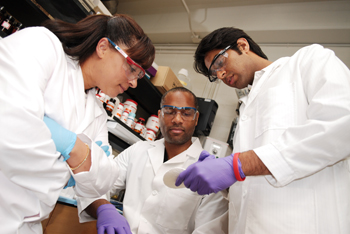Planning a new building on old Prentice hospital site

Chicago has an opportunity to become a global leader in medical research and lead the way in finding tomorrow’s cures. If Northwestern University is allowed to build a new research center on the site of the old Prentice Women’s Hospital, the University would attract an additional $150 million a year in new medical research dollars, create 2,000 new full-time jobs, and generate an additional $390 million a year in economic activity in Chicago. The new center would attract some of the world’s best medical researchers to Chicago and house some of the best clinicians to assist those in Chicago struggling with disease. Chicago is a world-class city, fast becoming a global leader in innovation. Now, we have a chance to be a global leader in medical research. Chicago can find tomorrow’s cures, if we let it.
Chicago—and the world—will benefit from the new research, the care and the cures.
- Northwestern attracts $300 million a year in biomedical research grants and over the past decade has made great strides in medical research.
- By creating a new research center, Northwestern would attract an additional $150 million a year in new medical research dollars, enabling it to become one of the leading academic medical research centers in the world.
- In addition to helping Chicago find tomorrow’s cures, having the best medical researchers and clinicians here will improve the lives of those who live in Chicago and are struggling with disease.
- The modern facility will accelerate Northwestern research on cancer, cardiovascular disease, diabetes, and neurodegenerative disorders, among others.
Northwestern’s new investment in Chicago will benefit all Chicagoans, creating jobs and strengthening the local economy.
- Building a new research center would create more than 2,500 construction jobs and more than 2,000 new full-time professional jobs.
- The new research facility and medical research dollars, a significant investment in the city of Chicago, would contribute $390 million annually in net economic impact for Chicago.
The new research center has been part of Northwestern’s long-term plan to make Chicago a global leader in medical research.
- Northwestern has been planning to build this world-class research center for more than 15 years.
- The building would be part of a broader expansion of the existing University downtown research space, adding a series of adjacent buildings all connected to each other, floor by floor.
- Building this new facility is a critical step in a multi-decade plan to make Chicago a world-class leader in medical research.
Architects disagree on whether or not to give old Prentice landmark status.
- Architects do not agree on the worthiness of giving landmark status to old Prentice.
- In fact, most architects would agree that Marina City is a better example of Bertrand Goldberg’s work.
The neighborhood doesn’t support giving old Prentice landmark status.
- The community group representing thousands of residents in the surrounding Streeterville neighborhood does not support landmarking the old building.
Old Prentice cannot be renovated to create the research center needed to become a leader in finding tomorrow’s cures.
- The existing building cannot be renovated to provide the space needed to take full advantage of the research dollars that could help Chicago find tomorrow’s cures and change the lives of people across the globe.
- The old Prentice building’s floors cannot support today’s research equipment, and the vibration in old Prentice would not allow researchers to use advanced microscopes and other sensitive equipment.
- To attract the best medical researchers in the world, research space has to be state of the art in its configuration.
Using another site won’t work.
- Using another site as suggested by preservationists won’t work. The old Prentice site has critical adjacencies to our existing research buildings, and the ability of researchers to have physical
proximity to their colleagues is essential to their collaboration and productivity. - Northwestern University doesn’t own any of the sites suggested as alternatives. Additionally, the owners of those sites have plans for their future development.
- Preservationists also suggested using the building for residential or hotel space, but Northwestern is in the business of educating students and saving lives, not building condos or hotel rooms. Chicago became a world-class city by asking not what we have done, but what more can we do.
- Chicago got to where it is today by thinking about how to become a world-class city in the future.
- We should trust the scientists who found the cures of today to determine what is needed to find the cures of tomorrow.
Northwestern has a proven record of commitment to preservation, which will continue.
- The historic buildings on Northwestern’s Chicago campus designed by renowned architect James Gamble Rogers have been carefully maintained and renovated by the University for nearly a century.
- Northwestern University is committed to preservation and consistently wins historic preservation awards for the restoration and renovation of major buildings on its Evanston campus.

